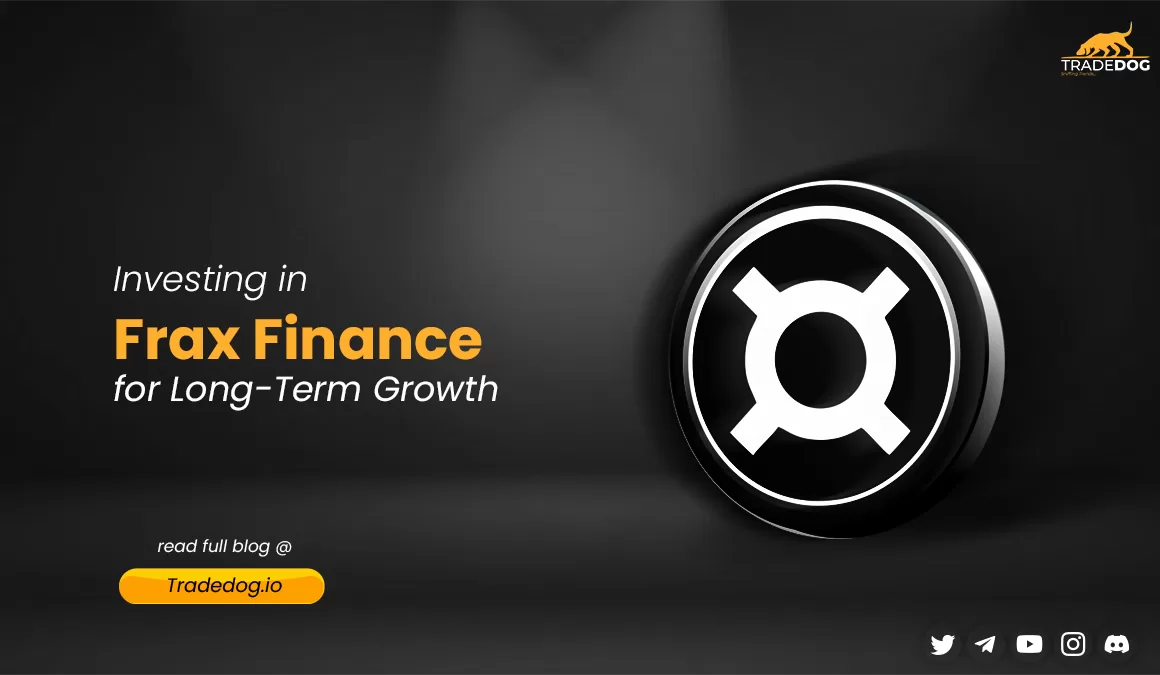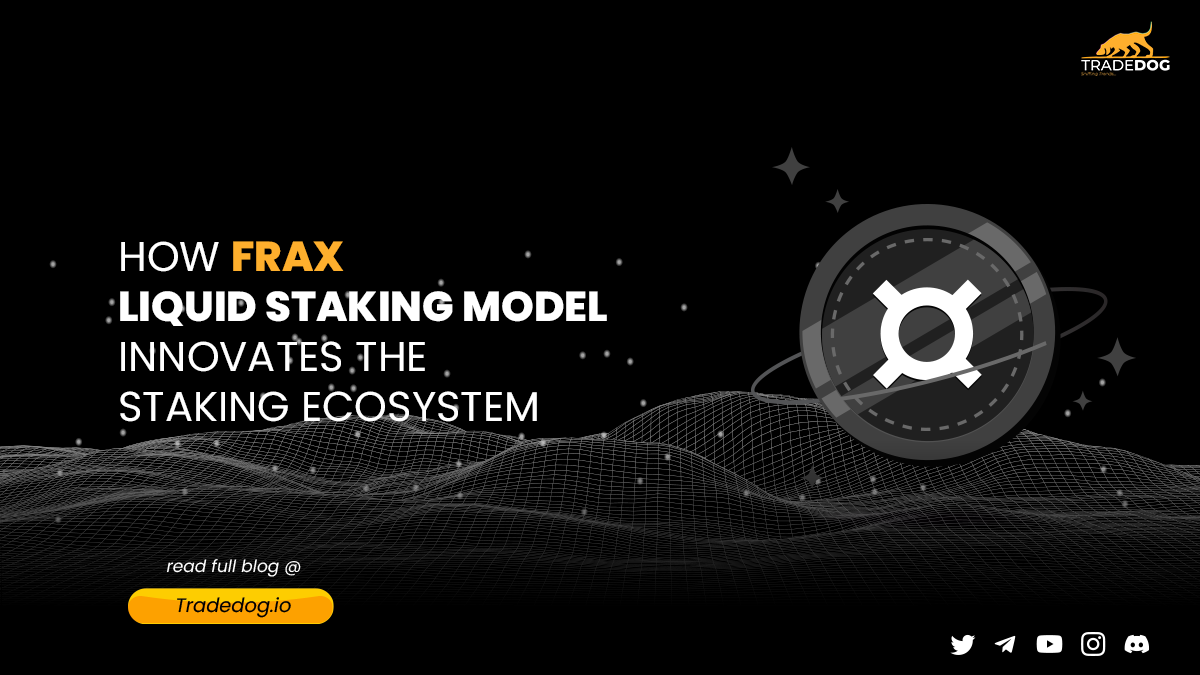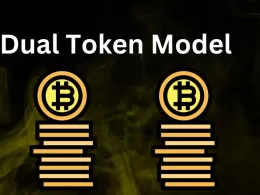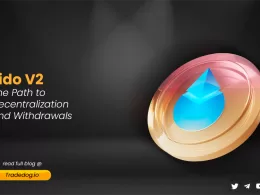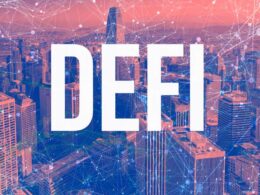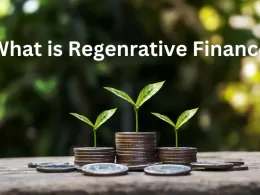Quick Links
- Frax Ecosystem: Industry Scope
- Frax Finance: Actual User Demand
- Frax Finance: Market Dominance
- Frax Finance: Tokenomics and Vesting
- Frax Finance: Treasury & Catalysts
- Frax Finance: Competitors
- Frax Finance: SWOT Analysis
- Strengths
- Weaknesses
- Future Catalysts
- Version 1 of Frax Finance relies on in-house validators to ensure the quality of the validations and generate more rewards. But, on June 3rd, 2023, the Founder of Frax Finance, Sam Kazemian, announced the launch of Frax Ether’s V2. And, you guessed it right, V2 is focused on making the model completely decentralized, and it is coming up with these significant innovations:
- Risks
- Conclusion: Analyst’s Opinion
Frax Finance is actively establishing a comprehensive DeFi ecosystem within the broader DeFi sector. At the heart of this ecosystem lies the Frax stablecoin (FRAX), which is specifically designed to retain a peg to the value of one US dollar. What sets Frax apart is its hybrid model, combining both on-chain and off-chain elements through a fractional algorithmic mechanism. This innovative framework enhances adaptability and efficiency in preserving the stability of the token’s value. If you don’t know about Frax Stablecoin, You can read here.
Frax Finance is building a comprehensive DeFi ecosystem by creating various protocols and products within its platform. These protocols work together to offer a wide range of user services and opportunities. Here are some key elements of the Frax Finance ecosystem:
- Frax Stablecoin (FRAX): At the core of the ecosystem is the Frax stablecoin, which is designed to maintain a 1:1 peg to the US dollar. FRAX combines algorithmic and collateralized stability mechanisms to achieve price stability.
- FraxSwap: FraxSwap is a decentralized exchange protocol within the Frax ecosystem. It allows users to trade FRAX and other assets with low slippage and minimal fees. FraxSwap functions similarly to popular DEX platforms, enabling users to swap tokens securely and vertically.
- FraxLend: FraxLend is a lending and borrowing protocol offered by Frax Finance. It allows users to lend their assets to earn interest or borrow assets against collateral. It also offers competitive interest rates and supports various assets, providing users with flexibility and opportunities to generate passive income.
- FraxFerry: FraxFerry is the bridging solution to move assets across different chains. This is compatible with 13 chains, similar to Stargate Finance and Synapse network, with more chains integrated.
- Frax Ether: Frax Ether can be likened to liquid staking protocols such as Lido Finance and RocketPool. One notable advantage offered by Frax Ether is its higher Annual Percentage Yield (APY). This enhanced APY is achieved through a unique approach that integrates two tokens, departing from the traditional Liquid Staking Derivative (LSD) models. If you don’t know about Frax Ether, read it here.
- Frax Price Index: The Frax Price Index (FPI) is the second stablecoin of the Frax Finance ecosystem. FPI is the first stablecoin pegged to a basket of real-world consumer items as defined by the US CPI-U average. The FPI stablecoin is intended to keep its price constant to the price of all items within the CPI basket and thus hold its purchasing power with on-chain stability mechanisms.
By integrating these protocols and products, Frax Finance aims to create a self-sustaining and interconnected DeFi ecosystem. This comprehensive approach provides users a seamless and holistic DeFi experience under one roof.
Frax Ecosystem: Industry Scope
Since its inception, the decentralized finance (DeFi) sector has experienced explosive growth. In 2020, the TVL in DeFi protocols surged from around $1 billion to over $14 billion, highlighting users’ increasing adoption and interest. By November 2021, the TVL reached a staggering $179 billion, showcasing the sector’s rapid growth. This growth demonstrates the significant amount of capital being deployed and locked within DeFi protocols for various purposes such as lending, borrowing, and yield farming.
Furthermore, Ethereum’s shift from POW to POS brings more liquidity to the DeFi ecosystem. New innovative protocols like Lido, Rocketpool, etc., provide additional ways to increase the use case of your staked tokens. As a result, Lido is the most significant player in the DeFi liquid staking sector with $13.50Bn out of TVL of $46.45Bn with a dominance of ~30%.
The future outlook for the DeFi sector remains promising. The industry is expected to continue its growth trajectory, attracting more capital, users, and developers. Integrating layer two scaling solutions and expanding to other blockchain networks beyond Ethereum will likely increase the scalability and accessibility of DeFi applications.
Frax Finance: Actual User Demand
| Metrics | Value |
| Daily Active Users (30D-Average) | 26.30 |
| Trading Volume (Annualized) | $526 billion |
| Fees (Annualized) | $16.45 million |
| Revenue (Annualized) | $1.65 million |
| Fully Diluted Market Cap (FDMC) | $648 million |
| Circulating Market Cap of Frax | $1.02 billion |
| Circulating Market Cap of FXS | $468 million |
| Circulating Market Cap of FRXETH | $97.60 million |
| Circulating Market Cap of FPIS | $45 million |
| Total Value Locked (TVL) | $795 million |
| FDV/TVL Ratio | 0.815 |
| P/F | 9.5x |
Frax Finance: Market Dominance
Frax Stablecoin has secured its position as the fourth largest stablecoin, boasting a circulating market capitalization of $1.03 billion. This achievement solidifies its status as one of the largest hybrid stablecoins available in the market. Impressively, within just 15-16 months, the cumulative volume on Fraxswap has reached $1.59 billion, generating $4.36 million in revenue with a total USD inflow of $6.075 million.
Moving on to Fraxlend, the total cumulative value of loans is $99.44 million, while the total borrowed value is $75.30 million. The Loan-to-Value (LTV) ratio remains healthy at 46%. The prominent pool on Fraxlend features Frax/CRV, and thus far, 82 liquidations have occurred, resulting in a profit margin of 9% per liquidation.
FraxDerry, conversely, is a permissionless, non-custodial, and secure method for transferring Frax Protocol tokens across various blockchains without the need for bridges or third-party applications. This versatile solution is compatible with 13 blockchain networks, enabling seamless interoperability.
FraxEther is an LSD protocol that employs a unique approach by integrating two tokens, thereby providing ETH stakers with a higher APY than other LSD protocols. Please refer to the provided resources for more detailed information on Frax Ether. Learn more about Frax Ether here.
Frax Finance: Tokenomics and Vesting
The fuel of the Frax ecosystem is the FXS token which is used as the payment mode, and users can also stake FXS tokens to earn rewards. The Frax Share token (FXS) is the non-stable utility token in the protocol. It is meant to be volatile and hold rights to governance and all system utility. FXS supply is initially set to 100 million tokens at Genesis, but the amount in circulation will likely be deflationary as FRAX is minted at higher algorithmic ratios. The protocol’s design is such that FXS would be deflationary in supply as long as FRAX demand grows.
Out of the total supply of 100Mn FXS, 72.40 Mn FXS are already out in the market. 5.83% of the token supply is still locked in the smart contract. FXS is released on Daily Linear vesting with 10,360 FXS tokens released per day, but this will be halved on 20th December 2023 to 5,179.80 FXS per day.
60% of all FXS tokens will be distributed through various yield farming, liquidity incentives, and exclusive governance proposals over several years. Thus, a maximum of 60,000,000 FXS will be distributed to the community for liquidity programs and other Defi initiatives as they appear in the space as voted by governance. 5% of all tokens are allocated to Project Treasury, grants, partnerships, and security bug bounties via team and community discretion.
20% of all FXS tokens will be distributed to the team, founders, and early project members. 3% are advisory tokens allotted for strategic work done in legal, technical, and business efforts to advance the adoption of the Frax protocol. The tokens are vested evenly over three years. 12% are distributed to accredited private investors.
Frax Finance: Treasury & Catalysts
Frax Finance has a treasury of approximately $215.60Mn from its all-time high of $336.50Mn on 16th April 2023. Distributing fees to token holders as passive income airdrops to long-term liquidity providers or user fees for token buybacks & burns could catalyze Frax Finance into the next market cycle.
Frax Finance: Competitors
Frax Finance is creating a one-stop shop for everything DeFi, from DEX to bridge to LSD. It has created a whole ecosystem of all the DeFi use cases under one roof. Also, Frax is not just integrating all the tools but launching these features with unique angles. For instance, the Frax stable coin uses a hybrid model incorporating centralized and algorithmic angles. The Frax Ether can provide higher APY because it uses two tokens instead of just one. Frax Finance is solving all these efforts to mitigate the risks hampering the growth of DeFi. Also, None of the other DeFi platforms is coming closer to it if we talk about the features and the distinctiveness it is trying to inculcate in its products. Therefore, all these parameters show the probability of upside potential for Frax Finance is highly likely.
Frax Finance: SWOT Analysis
Strengths
- Frax stands apart from its competitors in the DeFi sector by being the only platform to create a comprehensive ecosystem of successful products. Its full suite encompasses a hybrid stablecoin, decentralized exchange (DEX), lending and borrowing capabilities, a bridge for seamless interoperability, Liquid Staking Derivatives (LSD), and a financial instrument pegged to the US Consumer Price Index.
- As awareness of DeFi continues to grow among the general population, there is a strong likelihood that individuals will seek out a platform like Frax Finance, which offers a diverse range of use cases all in one place. The convenience and efficiency of accessing multiple functionalities within a single ecosystem make Frax Finance an attractive choice for DeFi enthusiasts.
- Frax Ether’s unique model of integrating two tokens enables its users to get the max APY compared to its competitors. The above chart shows that frxETH and sfrxETH are the two tokens. Frax allows its users a choice; they don’t automatically receive staking rewards.: they can either get a share in the staking rewards through the sfrxETH vault or explore other opportunities to earn higher returns on their fixed.
- Frax Finance is are one of the largest holders of $CRV and $CVX and are able to boost rewards. You can learn more about this amazing Flywheel between Frax finance, Curve Finance and Convex Finance here.
Weaknesses
- Limited Market Presence: Compared with other DeFi protocols, Frax Finance has a relatively small market share or little brand recognition compared to well-established competitors in the financial industry. It’s not dominating any subsector in the DeFi.
- Governance and Decision-Making: Frax Ether’s governance structure is primarily controlled by the Frax protocol and its associated entities. To ensure the quality of early validators, Frax relies on in-house validators in V1.
- Oracles: Frax Ether relies on external price oracles to determine the value of its collateral and maintain its stability. The selection and management of these oracles often involve a centralized decision-making process, introducing a centralization risk if the oracles are compromised or controlled.
Future Catalysts
Version 1 of Frax Finance relies on in-house validators to ensure the quality of the validations and generate more rewards. But, on June 3rd, 2023, the Founder of Frax Finance, Sam Kazemian, announced the launch of Frax Ether’s V2. And, you guessed it right, V2 is focused on making the model completely decentralized, and it is coming up with these significant innovations:
- World’s first market set Interest rate set for borrowing Validators
- Naturally, most competent and permanent node operators, since the Utilization rate sets the rates
- The agnostic lending market allows for any collateral, LTV, and Loan duration will be approved by veFXS
- frxETH will be backed by these overcollateralized Validator loans.
If you want to learn more about the upcoming updates, You can refer to this Twitter thread.
Risks
The rapid evolution of the LSDFi sector introduces risks for Frax finance. One notable success story in this sector is Rocketpool, which enables mini pools where users can lend 8 Ether to borrow a validator. Recently, protocols like Strader Labs have emerged, allowing the creation of even smaller micro pools with 4 Ether. These innovations promote decentralization and mitigate risk. However, it’s important to note that Frax stablecoin, partially collateralized by other assets, remains susceptible to volatility and devaluation of the underlying collateral. A significant drop in collateral value could raise concerns about the stability of Frax.
The LSDFi sector has become a prominent topic in the cryptocurrency industry, and the success of Frax stablecoin relies heavily on its adoption and the trust it garners from users and the broader market. If Frax fails to gain sufficient adoption or encounters negative sentiment, it may face challenges maintaining its peg to the intended value. Therefore, establishing trust and attracting a broad user base is vital for the long-term viability and stability of Frax stablecoin.
Conclusion: Analyst’s Opinion
If we see the below chart, the waiting time for entering the queue for new validators is 42 days, and for exiting the queue, it is 0. It shows the market’s interest to enter into the Ethereum LSD market.
Also, The skew of TVL from the most extensive protocol to the second place is over $11b; This means there’s incredible room for growth for innovative protocols. We believe Frax’s unique LSD approach aligned with the two token systems, and the announcement of V2 of Frax Ether will be a game changer for Frax in the coming few quarters.
Secondly, FXS tokenomics are deflationary, and the next halving cycle is scheduled for 20th December 2023, which will half the daily release supply to be 5179.8 tokens/day. This can also act as a catalyst for the gains in FXS tokens. Additionally, per the technical charts of the FXS token, it is trading very near its major support zone of $4.5-$5, making it an even more attractive investment opportunity considering the current levels.
Considering all the above parameters, intense buying pressure can be expected in the coming months once the overall bearish cycle improves.





